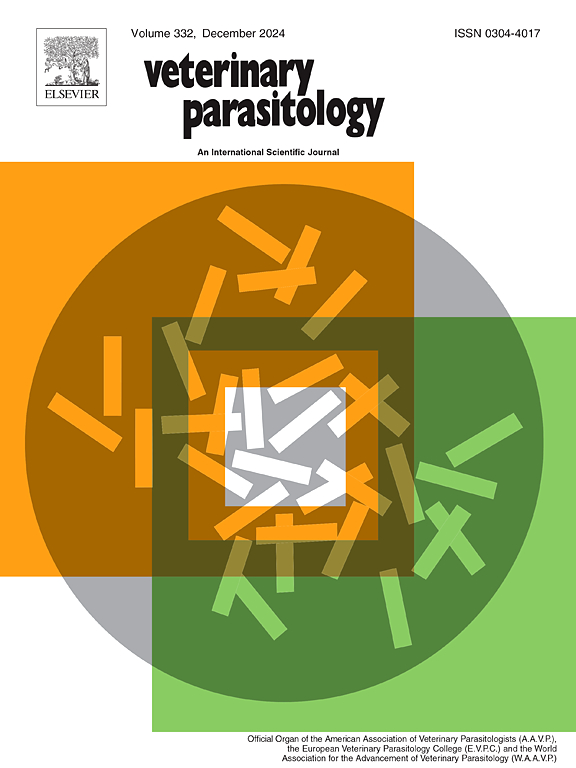棕榈叶提取物、挥发油、主要萜烯和银纳米颗粒对稳定蝇(双翅目:蝇科)的生物活性及其对稳定蝇寄生蜂(膜翅目:羽蛾科)和蚯蚓的非靶效应
IF 2
2区 农林科学
Q2 PARASITOLOGY
引用次数: 0
摘要
稳定的苍蝇,Stomoxys calcitrans,是一种世界性的有毒双翅目吸血昆虫,具有兽医和医学重要性。开发环保的绿色农药来控制稳定的苍蝇,同时避免合成农药对健康和环境的危害,这是一个新的兴趣。在此框架下,采用加氢蒸馏法制备了石竹精油(EO),并采用气相色谱- fid和气相色谱-质谱(GC-MS)对其进行了分析。主要成分为异丁香酚(33.1% %)和邻苯二甲酸二丁酯(29.3% %)。采用甲醇(MeOH)提取物制备了银纳米粒子(Ci-based AgNPs),并用显微镜和光谱仪器对其进行了表征。这些植物化学物质对仙人掌具有很强的杀虫活性。外用时,基于ci的AgNPs表现出最强的生物活性,其次是EO、邻苯二甲酸二丁酯、异丁香酚、MeOH和水提取物。在测试浓度为160 µg/苍蝇时,基于ci的AgNPs和EO在24 h后杀死所有昆虫。LC50值在41.1 ~ 124.6 µg/fly之间。熏蒸效果最好的熏蒸剂是EO,其次是异丁香酚、ci基AgNPs和邻苯二甲酸二丁酯,其中24 h熏蒸LC50在20.8 ~ 73.7 µL/L空气之间。植物性药物显著抑制昆虫乙酰胆碱酯酶(AChE)的生物活性。非靶效应表明,这些植物化学物质对拟寄生虫卡氏Spalangia cameroni具有可接受的安全边际,LC50值在988.18 ~ 2000µL/mL之间。当浓度达到200 mg/kg土壤时,它们对蚯蚓(Eisenia fetida)是安全的。研究结果证实了石蜡提取物、环氧乙烷和纳米颗粒作为生态友好型绿色杀虫剂的潜力。本文章由计算机程序翻译,如有差异,请以英文原文为准。
Bio-activities of Clerodendrum inerme extracts, essential oil, main terpenes and Ag nanoparticles against the stable fly, Stomoxys calcitrans (Diptera: Muscidae) and their non-target effects against its parasitoid, Spalangia cameroni (Hymenoptera: Pteromalidae) and earthworms
The stable fly, Stomoxys calcitrans, is a cosmopolitan noxious dipteran hematophagous insect of veterinary and medical importance. There is a renewed interest to develop eco-friendly green pesticides to control stable flies while avoiding the health and environmental hazards of synthetic pesticides. In that framework, Clerodendrum inerme essential oil (EO) was produced by hydrodistillation, and analysed by using (GC-FID) and GC-MS). Isoeugenol (33.1 %) and dibutyl phthalate (29.3 %) were identified as the main components. Silver nanoparticles (Ci-based AgNPs were produced using the methanol (MeOH) extract and characterized using microscopic and spectroscopic instruments. The phytochemicals exhibited considerable insecticidal bioactivity towards S. calcitrans. Using topical application, Ci-based AgNPs displayed the strongest bioactivity, followed by EO, dibutyl phthalate, isoeugenol, MeOH, and aqueous extracts. At a test concentration of 160 µg/fly, Ci-based AgNPs and EO killed all insects after 24 h. The LC50 values ranged between 41.1 and 124.6 µg/fly. Using fumigation, the EO was the strongest fumigant, followed by isoeugenol, Ci-based AgNPs, and dibutyl phthalate, where the 24 h fumigation LC50’s ranged between 20.8 and 73.7 µL/L air. Botanicals substantially inhibited insects' acetylcholinesterase (AChE) bioactivity. Non-target effects revealed that the phytochemicals showed an acceptable safety margins towards the parasitoid, Spalangia cameroni with LC50 values ranged between 988.18 and ˃ 2000 µL/mL. They were considered as safe for earthworms, Eisenia fetida, at concentration up to 200 mg/kg soil. The results confirm the potential of using C. inerme extracts, EO and nanoparticles as eco-friendly green insecticides against S. calcitrans.
求助全文
通过发布文献求助,成功后即可免费获取论文全文。
去求助
来源期刊

Veterinary parasitology
农林科学-寄生虫学
CiteScore
5.30
自引率
7.70%
发文量
126
审稿时长
36 days
期刊介绍:
The journal Veterinary Parasitology has an open access mirror journal,Veterinary Parasitology: X, sharing the same aims and scope, editorial team, submission system and rigorous peer review.
This journal is concerned with those aspects of helminthology, protozoology and entomology which are of interest to animal health investigators, veterinary practitioners and others with a special interest in parasitology. Papers of the highest quality dealing with all aspects of disease prevention, pathology, treatment, epidemiology, and control of parasites in all domesticated animals, fall within the scope of the journal. Papers of geographically limited (local) interest which are not of interest to an international audience will not be accepted. Authors who submit papers based on local data will need to indicate why their paper is relevant to a broader readership.
Parasitological studies on laboratory animals fall within the scope of the journal only if they provide a reasonably close model of a disease of domestic animals. Additionally the journal will consider papers relating to wildlife species where they may act as disease reservoirs to domestic animals, or as a zoonotic reservoir. Case studies considered to be unique or of specific interest to the journal, will also be considered on occasions at the Editors'' discretion. Papers dealing exclusively with the taxonomy of parasites do not fall within the scope of the journal.
 求助内容:
求助内容: 应助结果提醒方式:
应助结果提醒方式:


